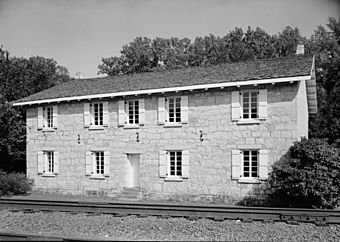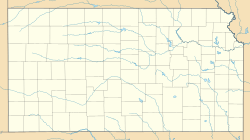First Territorial Capitol of Kansas facts for kids
Quick facts for kids |
|
|
First Territorial Capitol
|
|

First Territorial Capitol at Fort Riley
|
|
| Nearest city | Junction City, Kansas |
|---|---|
| Area | 2.8 acres (1.1 ha) |
| Built | 1855 |
| NRHP reference No. | 70000249 |
| Added to NRHP | December 2, 1970 |
The First Territorial Capitol of Kansas is a very important historical building. It's the only building left from the old town of Pawnee, Kansas, which is now a "ghost town." This building was the capital of the Kansas Territory for just five days in 1855! After that, the capital moved to other places.
Today, the First Territorial Capitol is a history museum. It's run by the Kansas Historical Society and helps people learn about Kansas's early days.
Contents
Where is the Capitol and How Was It Built?
The capitol building is in a valley in northeastern Kansas, very close to the Kansas River. It used to be on the edge of Fort Riley, but now it's actually inside the military base. The land around the building, about 2.8 acres, was given to the Kansas Historical Society in 1928. A group of trees separates the building from the river, and train tracks run nearby.
Building the capitol started in 1855 with about 30 workers. The building is about 40 feet wide and 80 feet long, and it has two floors. Both floors were designed as large meeting halls. Stairs on the south side connect the floors.
The building's foundation and walls are made from local limestone. There's a stone chimney at each end. The ceilings show the wooden beams that support the roof. The doors are made of wood with stone doorsteps, and the window sills are also stone. People probably used hanging lanterns for light back then.
During its restoration in 1927, new wood was used. Workers chipped it to make it look like it was cut by hand, just like in the 1850s. The floors were made of thick wooden planks held down with iron nails. The doors and windows had special metal parts that were shaped by hand. The roof was covered with large wooden tiles that looked like old-fashioned shakes.
A Look Back: The Capitol's History
The First Lawmakers Meet
The very first group of lawmakers for the Kansas Territory met in this capitol building. Their meeting was short and full of arguments, lasting only five days from July 2 to July 6, 1855. They didn't like the location or the building's condition. Even before they arrived, they wanted to move closer to Missouri, where many of them had been unfairly elected.
There were 13 members in the "council" (like a senate) who met on the second floor. Another 26 members were in the "house" (like a house of representatives) who met on the first floor. Out of all 39 lawmakers, only eight wanted Kansas to be a "free state" (without slavery). The other 31 wanted Kansas to allow slavery. Their ages ranged from 23 to 55.
One of their first actions was to remove almost all the free-state lawmakers. They did this by canceling earlier election results and holding a new election that put pro-slavery men in their places. This is why this group of lawmakers became known as the "Bogus Legislature."
On July 3, the Territorial Governor, Andrew Horatio Reeder, gave a speech. During his speech, the only remaining free-state lawmaker stood up and spoke out against the governor and his colleagues. People at the time said that the debates in the capitol included strong phrases like "justice for all" and "Southern rights." They also heard calls for "Kansas, the brightest star of all."
On July 4, the lawmakers quickly passed a bill to move the capital to Shawnee Mission. They even voted to overrule the governor's decision to stop the move. After their meeting ended on July 6, they packed up and left for the new location, with the governor having to follow them.
The Capitol Building's Journey
Governor Reeder had announced in April 1855 that the lawmakers would meet in Pawnee. This caused a rush to build things in the town, including the capitol. However, the building wasn't completely finished when the meeting started. The floorboards weren't nailed down, windows and doors were missing, and the roof wasn't done. There was even a large hole in the wall on the second floor! The builders worked day and night, even on Sunday, to try and finish. This upset the lawmakers because Pawnee was a town that respected Sunday as a day of rest. One lawmaker reportedly said, "No good law could ever be enacted within the four walls that had witnessed such desecration."
Other Uses Over Time
After the lawmakers left, people found the building messy inside. Later, one person even lived on the second floor. When the town of Pawnee was ordered to be torn down and its land became part of Fort Riley, the first floor of the capitol became a place for the army's food supplies. Most of Pawnee's buildings were destroyed, but the old capitol was saved.
Over the years, it was used for many different things. In September 1855, it was a place where people voted in another election. The Army used it as a storage building, and it also held a wood shop. After a tenant moved out, it was used as a club for single men and a place for ministers to work.
Bringing the Capitol Back to Life
After Pawnee was gone, the first capitol building was neglected. In 1877, a strong windstorm tore off the roof, causing a lot of damage inside. People started talking about saving the building around 1900. In 1907, a man named Col. Samuel F. Woolard began raising money to restore it. He later became the president of the Kansas Historical Society. Some of the restoration work was based on the memories of John Martin, who had been a clerk for the first group of lawmakers.
By 1908, enough money was raised to do a lot of repair work. Stones in the walls were replaced, and windows and doors were straightened. Cracks were filled with cement, and the walls were covered with plaster after being made stronger with iron. The Union Pacific Railroad company, which owned some of the land, was also interested in helping. This railroad company was actually started by the first legislature!
In 1926, Governor Ben Paulen asked the state lawmakers to help with the restoration. A bill was passed to give $1,000 for the cause. However, just replacing the roof cost $2,000, and the Union Pacific Railroad ended up providing over $20,000 for the entire project. Old benches, chairs, desks, and stoves were bought to make the inside look like it did in the 1850s. The outside grounds were cleaned up, and new walkways were built.
In 1927, the building was officially recognized as a National Historic Place. On August 1, 1928, the site was officially opened again.
The president of Union Pacific, Carl R. Gray, wanted a big celebration to give the site to the State of Kansas. The company planned and paid for a huge party! Ten thousand people came. Special trains brought people and a collection of old items to see. People from Fort Riley performed military ceremonies and played music. Native Americans also performed tribal dances. A flag that had flown over the Memorial Building in Topeka at the end of World War I was raised over the capitol. Governor Paulen received a special salute, and he reviewed the National Guard troops. Barbecue was served to everyone!
A pretend legislative session was held, led by State House Speaker D. M. Hamilton. All the lawmakers attending wore clothes from the 1850s. Governor Paulen read Governor Reeder's original message from 1855. During the session, a costumed man stood up and gave a fiery speech, saying he was from Missouri and demanded a seat in the legislature. The other actors pretended to threaten him, but then everyone's attention was drawn to a fake Indian attack outside the building!
Many important people attended the celebration, including:
- Governor and Mrs. Paulen
- Lieutenant Governor D. A. N. Chase
- Former Kansas Governor Willis J. Bailey
- U.S. Senator Charles Curtis
- U.S. Senator Arthur Capper
- Union Pacific President Gray
By 1958, trees planted near the entrances had grown too big and blocked the doorways. These were removed before state lawmakers met for a real session, for one day, in 1961. This was part of the state's 100-year anniversary celebrations.
The Capitol as a Museum
The capitol building officially became a history museum in 1928. At its dedication on August 1, Nelson H. Loomis, a lawyer for Union Pacific, gave a speech. He said that those gathered there were dedicating the building to remember the brave people who helped create the state and build its railroads.
Today, the First Territorial Capitol State Historic Site has exhibits about the Kansas Territory. You can learn about how people traveled by train and river in the area, and about the history of Pawnee. Since the museum is on an active U.S. Army base, visitors need to show photo identification to enter.






